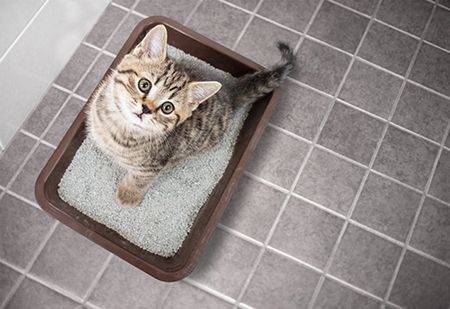Environmental enrichment: the key to ameliorating Pandora syndrome
Successful long-term management of Pandora syndrome involves treating the cat, the environment and, last but not least, the client.

Looking for a little hope. Multimodal environmental management of Pandora syndrome has five components, including litter box management. (AdobeStock/Andrey Kuzmin)In some cats, chronic lower urinary tract signs or other persistent health problems may be secondary to a multisystemic syndrome caused by chronic anxiety. Cats with this syndrome are best treated with environmental enrichment to reduce stress. This is according to Tony Buffington, DVM, PhD, DACVN, who spoke on the topic at the 2018 conference of the American Association of Feline Practitioners in Charlotte, North Carolina.
Dr. Buffington coined the term Pandora syndrome in 2011 to describe a constellation of feline disorders that likely result from chronic anxiety. Affected cats can have clinical signs related to several organ systems. Possible manifestations of Pandora syndrome include lower urinary tract disease, picky eating, overgrooming, aggression, vomiting, diarrhea, hiding and other medical or behavioral disorders, said Dr. Buffington, a clinical professor at the University of California, Davis, School of Veterinary Medicine and emeritus professor at The Ohio State University College of Veterinary Medicine.
Pandora syndrome results from activation of the central stress response system, Dr. Buffington said. This system, which incorporates elements of the endocrine, immune and autonomic nervous systems, responds when an animal's perception of threat exceeds its perception of control. Individual animals respond to chronic stressors in different ways because of genetic factors and traumatic events (including those occurring prenatally) that sensitize the central stress response system to the environment.
Diagnosing Pandora syndrome
Because the chronic disorders that could potentially be attributed to Pandora syndrome have many other possible causes, Dr. Buffington advised that cats receive a complete physical examination and diagnostic workup to rule out other medical problems. Because Pandora syndrome affects more than one organ system, he recommended investigating the presenting problem last during the physical examination to reduce the chance of overlooking a comorbidity.
Dr. Buffington gives owners health history and household evaluation questionnaires to reveal adverse early experiences, stress-associated behaviors and stressful environmental conditions. These questionnaires are also a way to start a conversation with clients about a cat's home environment, he said, adding that he “praises the client for everything they are doing right and offers coaching for areas that may benefit from modification."
The following criteria support a diagnosis of Pandora syndrome. The diagnosis is effectively confirmed if all of a cat's signs of illness respond to environmental enrichment, Dr. Buffington said.
> History of adverse experience (e.g. being orphaned or bottle fed, trauma, environmental instability)
> Evidence of comorbidities or additional sickness behaviors
> Clinical signs that wax and wane in response to changes in the environment
> Clinical signs that improve with multimodal environmental modification
Dr. Buffington said Pandora syndrome can be excluded if the diagnostic workup reveals another cause of illness or if the history and test results are not compatible with Pandora syndrome. He noted that cats with Pandora syndrome may also have signs of illness that are more severe than the underlying pathology would seem to suggest. Those without the syndrome are more likely to have signs of illness in proportion to the severity of the disease process.
Acute care
Medical treatment for cats with Pandora syndrome depends on the individual cat's specific needs. Hospitalized cats benefit from modifications to the cage and clinic environment designed to reduce stress.
Cats are less stressed in top cages than in bottom cages, Dr. Buffington said. Cages should include a hiding place, a cover over the door to reduce stimulation and bedding that completely covers the cage floor. Bedding that carries the scent of the cat or its owners may reduce the cat's perception of threat. He recommended changing bedding only when soiled, not daily, to avoid removing the cat's scent. Spot cleaning (rather than full cage cleaning) helps preserve the scent. Food and water should be placed in the back of the cage near the hiding place. The litter box, which is used less often than food and water bowls, should be at the front of the cage. Sometimes cats under stress rearrange items in the cage. “When you clean the cage and put it back together,” he suggested, “put everything where the cat had it.”
The clinic environment outside the cage can also be modified. Putting lights on timers (if natural light is not available) and cleaning cages at the same time every day improve the predictability of the environment. Ambient sounds and noxious odors (from dogs, perfumes, alcohol-based hand sanitizers, cleaning solutions, etc.) should be minimized. Calming music, warm ambient temperature, low-stress handling techniques and attention from a dedicated caregiver can also help.
Staff should monitor hospitalized cats for physical and behavioral signs of stress. These parameters can also be used to evaluate the effectiveness of environmental modifications. Signs of stress in hospitalized cats include:
> Resting in the litter box (a sign that a cat is cold or fearful, Dr. Buffington noted)
> “Trashing” the cage or, conversely, apparently not moving around the cage at all
> Sickness behaviors: vomiting, diarrhea, inappetence, lethargy, failure to groom, eliminating outside the litter box, not eliminating at all
> Increased respiratory rate, heart rate and blood pressure
> Licking lips, sweating from paw pads
> Increased withdrawal behaviors: hiding, freezing, attempting to escape, becoming defensively aggressive
> Decreased approach behaviors such as purring, kneading and soliciting attention from caregivers
Chronic care
Long-term management of Pandora syndrome involves treating the client, the cat and the environment, Dr. Buffington said. Environmental enrichment benefits all indoor cats, not only those with Pandora syndrome.
Treating the client. Client communication is the most important component of successful treatment, Dr. Buffington said. Owners are often frustrated by their cats' chronic problems, so he suggested empathizing with clients and listening carefully to their concerns. “Explain to owners that Pandora syndrome is manageable-although not curable-and enlist them as partners in their cats' treatment,” he recommended. Cat owners are responsible for implementing environmental enrichment, he pointed out, so the success of treatment depends on their commitment to the plan. Effective, empathetic communication helps decrease clients' anxiety about their cats and can improve adherence to treatment.
Treating the cat. The effectiveness of dietary therapies for illnesses related to Pandora syndrome has not been studied thoroughly, Dr. Buffington said. A number of drugs have been used to treat lower urinary tract signs in cats, and anxiolytic drugs are also available. However, he said, these medications are either of questionable benefit for lower urinary tract disease or have not been evaluated fully for long-term use in cats. He pointed out that no behavioral drugs are currently approved in the United States for use in cats.
Treating the environment. The goals of environmental modification are to reduce cats' perception of threat and increase their perception of control. Enriched environments allow animals in captivity (including indoor cats) to participate in species-appropriate activities and feel safe, Dr. Buffington said. Effective multimodal environmental modification for indoor cats has five components:
1. Space: Cats should have a safe refuge (like a carrier to which the cat is habituated) and multiple options for scratching, climbing and hiding.
2. Food: Cats need to be able to eat alone and undisturbed in a quiet location. Offering new foods in separate containers rather than mixed together allows cats to choose their food. Food puzzles or toys can allow cats to simulate natural predatory behavior.
3. Litter boxes: Litter box size, location, number and substrate can all affect cats' urinary behaviors.
4. Play: Owners should provide toys for cats that enjoy them. Some cats respond well to positive-reinforcement training to do tricks; others prefer simply to be petted.
5. Conflict management: Cats in multiple-cat households may develop conflict over resources (e.g, food, litter boxes) or threats to their status.
Dr. Buffington suggested that practitioners consult additional resources for environmental enrichment for indoor cats, including these guidelines. The American Association of Feline Practitioners and the Indoor Pet Initiative also offer information for cat owners.
Follow up with owners to provide support and assess the cat's response to treatment, Dr. Buffington advised. His goals for owners are decreased frustration and increased empathy for the cat; goals for cats are fewer clinical signs and more positive behaviors.
Dr. Walden received her doctorate in veterinary medicine from North Carolina State University. She is a practicing veterinarian and a certified editor in the life sciences (ELS). She owns Walden Medical Writing, LLC, and writes and edits materials for healthcare professionals and the general public.
